Many webinar hosts struggle to find a platform that lets them engage their audience and generate leads or conversions. To help you find the right fit for your needs, we've created an in-depth comparison between three webinar software tools:
-
WebinarJam
-
Zoom
-
eWebinar (our own webinar platform)
This guide will cover the key differences between these webinar platforms, their main features, and any pricing considerations:
NOTE: We understand you might be worried about us being biased towards our own webinar tool which is why we're not asking you to take our word for it. You can watch our demo to see the software in action for yourself (because we use eWebinar to demo eWebinar).


Let's dive in!
WebinarJam vs Zoom vs eWebinar: Platform Overviews and Key Differences
WebinarJam, Zoom, and eWebinar all have their own benefits and drawbacks. However, the first two were built with live webinars in mind while our platform eWebinar was designed for hosts who want to save time and scale their webinars without sacrificing interactivity.
Note: If you’ve never considered doing automated webinars before, skip ahead to find out why they might be right for you and the kinds of webinars you host, such as sales demos, onboarding, and training webinars.
Before going into the side-by-side comparison of the features and pricing that these webinar platforms have to offer, let's take a quick look at the key differences between each webinar platform.
WebinarJam
WebinarJam is a live webinar platform. It doesn't support automated webinars but you can purchase its sister product, EverWebinar, separately to turn a live presentation on WebinarJam into an evergreen webinar. Learn more about the differences between the two in our EverWebinar vs WebinarJam guide.
WebinarJam differentiates itself in a few ways such as:
-
Offering customers a 30-day money-back guarantee instead of a 14-day free trial
-
Letting you export a webinar to EverWebinar (if you pay for both tools separately)
-
Accommodating up to six hosts and 5,000 attendees on the Enterprise plan
Zoom
Zoom is a video conferencing platform with a product named Zoom Webinars (which is what we'll be covering today). Its widespread adoption means Zoom carries the benefit of most people already using it for online meetings. In fact, Zoom meetings accommodate 300 million participants per day.
Zoom Webinars differentiates itself in a few ways such as:
-
Letting you host webinars that are up to 30 hours long
-
Offering virtual backgrounds with company branding
-
Built-in practice sessions for doing webinar dry runs
eWebinar
eWebinar is a webinar automation platform with real-time live chat, flexible scheduling capabilities, and over 20 unique interactions to insert into your presentations. eWebinar brings the interactivity of live webinars to the scalable world of pre-recorded webinars to help you get more attendees and customers.
eWebinar differentiates itself in a few ways such as:
-
Supporting both live chat and post-webinar email responses to questions
-
Offering a wider variety of interactions than any other pre-recorded webinar platform
-
Letting you enable all three scheduling types (on-demand, just-in-time, and replays) simultaneously.
We're going to give you a closer look at eWebinar in a bit but let's check out the other two tools first.
Here's a high-level breakdown of how eWebinar works:
1. Upload your pre-recorded video
There are a few options for uploading your video and transforming it into an automated webinar:
-
Upload a file of your webinar recording.
-
Paste in a YouTube link.
-
Use our Vimeo or Zoom integration.
eWebinar hosts your video so you can delete it after uploading to save storage space (unless you're using the Vimeo integration). If you’ve never created a pre-recorded webinar before then check out our full guide for the best practices to follow when recording a webinar.
2. Make your webinar interactive
Next to audio and video quality, interactivity is paramount to running a successful webinar. eWebinar offers over 20 interactions to choose from like polls, quizzes, and special offers that you can insert at any point in the video timeline.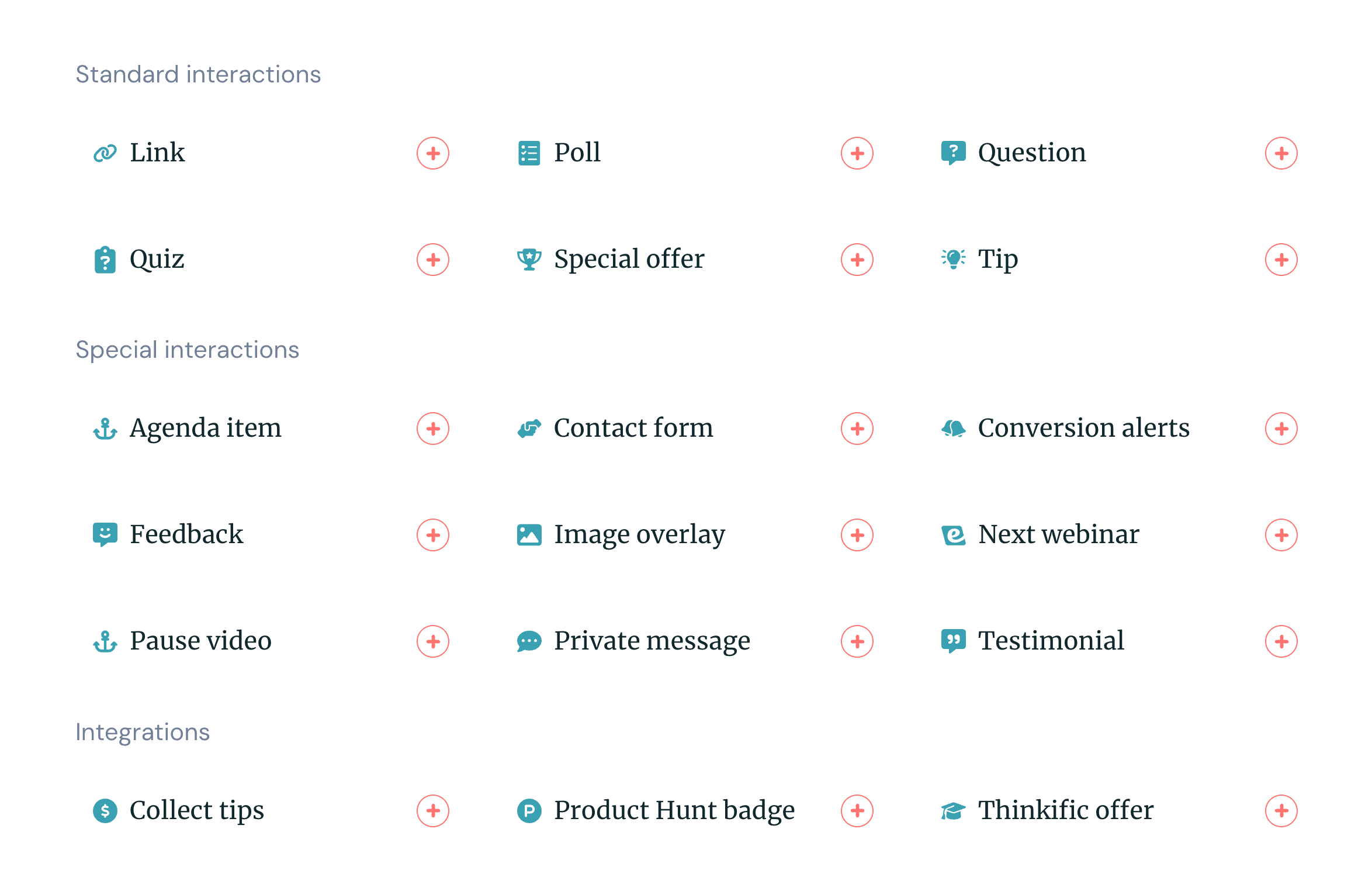
You can also automatically send all attendee responses to these interactions straight to your CRM or automate your post-webinar follow-up with third-party integrations. Lastly, our webinar analytics dashboard shows you where watch times drop off so you can strategically insert all the interactions.
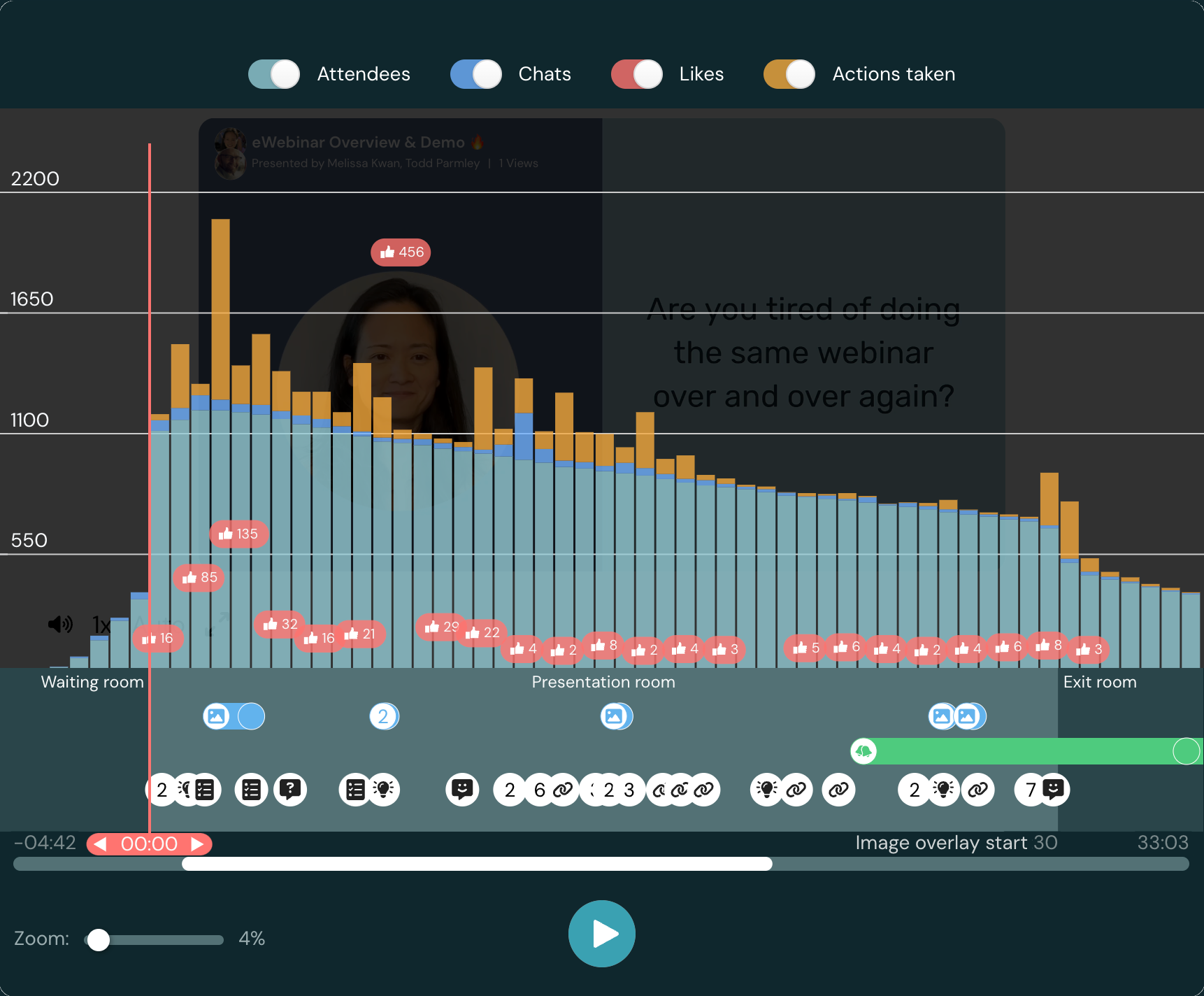
To learn more, read our full guide on How to Make a Webinar Interactive!
3. Schedule your automated webinar
Make your webinar available on-demand, set future webinars to repeat on a recurring schedule, and let registrants sign up to watch a replay.
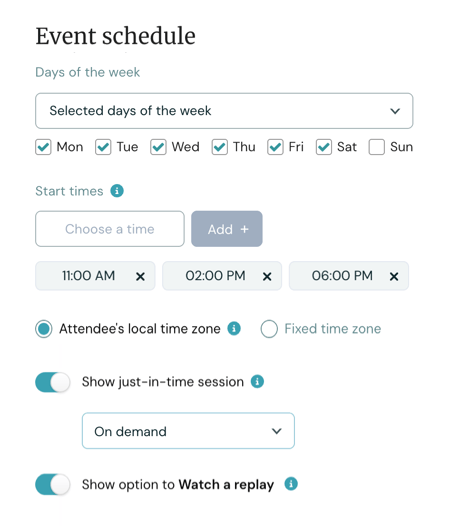
You can choose between three scheduling options (or enable all of them at once):
-
On-demand webinars
-
Recurring webinars
-
Webinar replays
You'll be able to use our chat and interaction features regardless of which scheduling type you use.
That said, we highly recommend enabling all three scheduling options simultaneously. We've found that increasing attendance rates comes down to making your webinars as convenient as possible to attend — with some of our customers increasing attendance by as much as 6x using this approach:
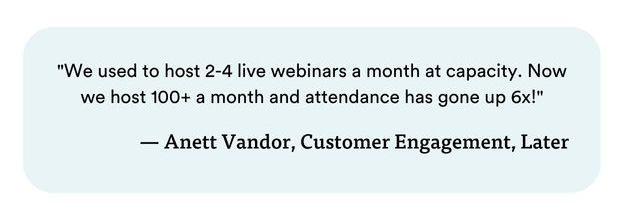
We'll give you a more in-depth overview of our scheduling options, live chat, and interactions below!
4. Set up your landing page and notifications
Finally, you can use our high-converting page builder to promote your upcoming webinar to potential registrants. Alternatively, you can embed our marketing widgets on pages made with dedicated landing page builders like Unbounce or Leadpages.
You'll also be able to set up multi-channel notifications through email, SMS, or WhatsApp to send registrants reminders about the webinar they've signed up for. For instance, you could automatically send out a reminder email one day ahead of the webinar and then a text 15 minutes before it starts.
eWebinar also streamlines the follow-up process for you through post-webinar email sequences. Most platforms only offer one or two pre-written emails. In contrast, all our webinar templates come with at least six emails included in their sequence.

The full process from upload-to-publish will take you less than 15 minutes to complete.
Once you publish your webinar you'll be able to use our live chat features to engage with attendees in real time or answer questions later through email. After publishing, you use our advanced analytics to measure your webinar's performance:
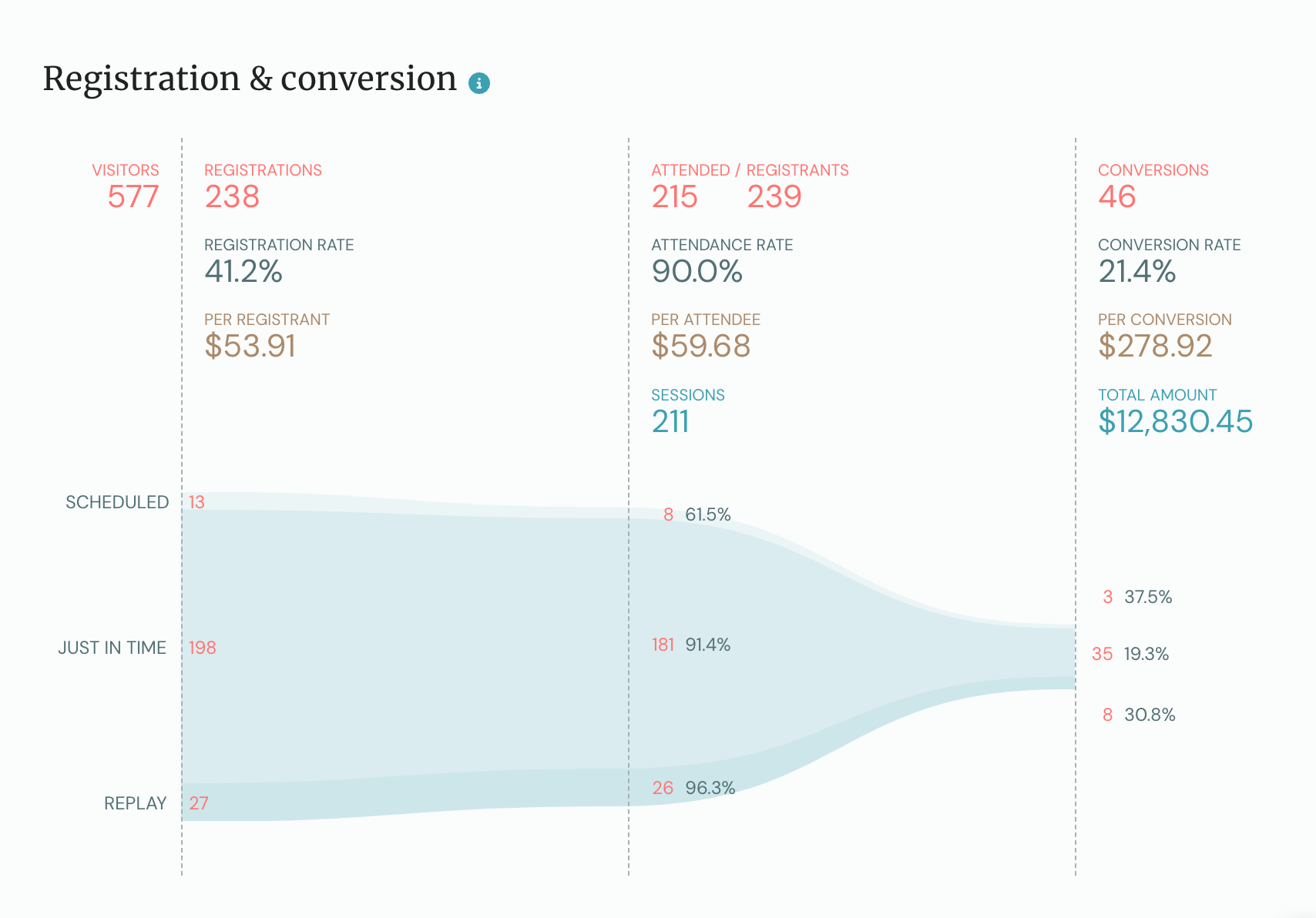
WebinarJam vs Zoom vs eWebinar: Feature Comparison
To help you choose the ideal webinar platform for your specific needs, here's a direct comparison of what each tool has to offer:
WebinarJam features
WebinarJam's biggest differentiator is its control panel. There are three panels for controlling chat, interactions, and attendees respectively. These panels can also be operated by a moderator which helps the host focus on the presentation (instead of responding to attendees or triggering interactions).
Note: The downside is that the moderator will need to be present for every single live webinar you host.
There's even a real-time statistics dashboard that shows you attendee information like how many are currently watching, how that compares to the peak audience size, and a historical graph of attendee volume in five-minute intervals.
You'll also be able to able to see how long you've been live, the number of sales you've made thus far, and the total revenue earned. These attendance and sales metrics help you keep track of webinar performance in real time so you can course-correct if needed.
Note: In contrast, you can only generate a Zoom Webinar registration report — with the list of registrants and their details — after the webinar ends.
Zoom features
Zoom Webinars has the usual features that you'd find in a Zoom meeting like virtual backgrounds, cloud recording, and polls. Another feature that's been carried over from meetings is breakout sessions. You can create a new webinar room by splitting the main room into up to 200 breakout sessions.
The webinar host can either split up these breakout sessions manually, let Zoom do it automatically, or allow attendees to choose which sessions they'd like to join. The host or co-host can also move between these sessions freely.
Attendees who are in a breakout room will be able to use the same audio, video, and screen-sharing capabilities that they'd have in a normal Zoom meeting. Once they return to the main webinar session, they'll be re-assigned to the listen-only role for webinar attendees.
The Zoom-WebinarJam comparison really comes down to how closely your webinars resemble meetings.
eWebinar features
Through a combination of analyzing data and interviewing customers, we've identified the three core features that make our product uniquely effective: chat, scheduling, and interactions. Let's take a closer look at the three cornerstones of the eWebinar experience!
Chat
Here's how eWebinar's live chat feature works:
-
Personalized greetings. Attendees are automatically welcomed by name when they join a webinar. This personalized chat message frees you from having to be there for yourself.
-
Chat notifications. Whenever an attendee sends a message during a webinar, you (or an assigned moderator) will receive notifications through email, browser, or Slack.
-
Live responses. You can respond to your attendees in real-time through any device with a browser or Slack. Our Slack integration lets you reply directly through Slack channels.
-
Automatic responses. If no one's available to respond then an automatic response will let attendees know that their message was received and tell them when to expect a reply.
-
Post-webinar responses. Any chat replies sent to an attendee after the webinar has ended will be automatically forwarded to the same email address they used to register.
Our chat system is built to ensure that every message receives a timely response — giving the attendee a great first impression of your brand and creating a golden opportunity to reach them at their peak moment of interest.
Scheduling
The reason our customers get an average attendance rate of 65% (with some getting upwards of 90%) is because of the wide array of scheduling options that our platform provides. There are three scheduling types for you to choose from:
-
On-demand webinars. On-demand sessions let attendees watch the presentation right after submitting the registration form. You can also use "just-in-time" sessions that schedule themselves to begin within a few minutes of a visitor seeing your webinar registration page.
-
Recurring webinars. Sessions that recur on a set schedule give registrants other options if they're not ready to attend the webinar immediately. You can use our dynamic time zone feature to automatically adapt the schedule based on where an attendee lives.
-
Webinar replays. Webinar replays — which come equipped with the same chat capabilities and interactions — let attendees pause, play, or skip around through your presentation with the same ease as a YouTube video.
We're one of the few automated webinar platforms that let you enable all three scheduling options simultaneously. Providing all these options at once makes it as convenient as possible for your registrants to attend the webinar which will increase webinar attendance.
In fact, our scheduling features often lead to a webinar attendance rate in the range of 80% to 90%:
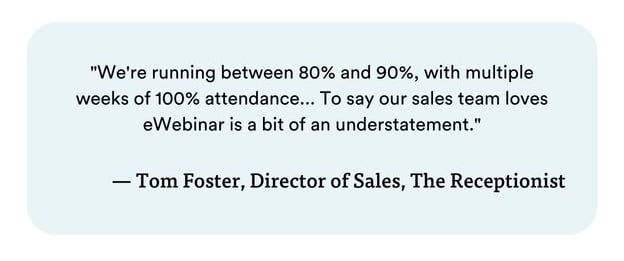
In comparison, the average attendance rate for those who host live webinars is just 40%.
Interactions
Interactions — such as polls, quizzes, handouts, etc. — let attendees participate in the webinar and keep them engaged until the end of the presentation. We recommend inserting an interaction every five minutes which would equal a dozen per hour.
Here's how eWebinar's 20+ interactions work:
-
Video timeline editor. Our user-friendly editor lets you insert interactions without writing any code or typing in timestamps. Simply drag the playhead to the point of the video, click on the plus icon, and choose your interaction.
-
Wide interaction variety. eWebinar has the largest selection of interactions of any webinar platform. This empowers you to create a webinar in your vision and ensures things don't get stale for attendees.
-
Customization. You can easily customize interactions by inserting text, emojis, images, or GIFs. This helps you get your personality and brand across to the audience. There are also multiple options for CTA interactions such as clickable offers versus contact forms.
-
Engagement data. The webinar analytics dashboard will show you the percentage of attendees that sent a chat message or interacted with an interaction. This will give you insight into which interactions resonate most with your audience or prompt them to engage through chat.
-
CRM integrations. eWebinar's third-party integrations let you forward data from customer interactions and forward it to your CRM platform like HubSpot or Salesforce. You can even use our Zapier integration to build marketing automations and connect other applications.
Don't mistake interactions for fancy bells and whistles, they're a crucial part of increasing your watch time and conversion rates.
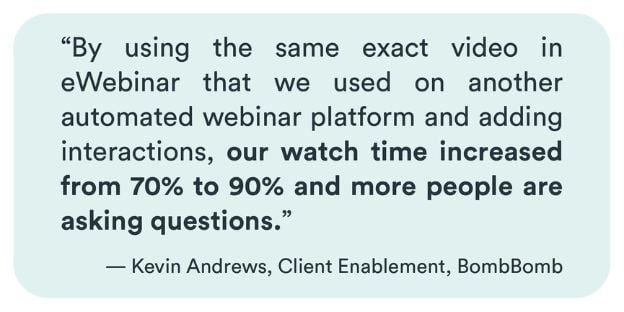
If you'd like to experience these interactions from an attendee's POV then watch our demo!


Should you use automated or live webinar tools?
Automated webinars are more scalable than live webinars because you can run hundreds of them without ever having to attend a single one yourself. That's not to say that live webinars are never the right option. Conversely, we'd recommend you use live webinars if:
-
You're hosting a one-time event
-
The content is different each time
-
You haven't tested your presentation
That last one is particularly important since it takes some trial and error in front of a live audience to hone your webinar script. Once you've identified the messaging that resonates and common questions/objections, you'll be in a better position to automate your presentation.
In other words, you can turn one great presentation into unlimited webinars.
From that point on, your sales and marketing efforts will consist of driving more leads to the top of your automated webinar funnel. Sales demos, onboarding, and training presentations are the kinds of webinars you’ll give over and over again.
Automating these types of webinars will save you time and actually convert better than if you were to host live webinars. With how time-consuming hosting webinars live is, it only makes sense to reclaim your time with an automated webinar feature set.
WebinarJam vs Zoom vs eWebinar: Pricing
Pricing isn't everything but it will impact how scalable your webinar efforts will be before they become too expensive to sustain. The more attendees you can afford to accommodate, the more value you'll be able to provide (and the more conversions you'll get).
Let's take a closer look at the pricing plans of each platform:
WebinarJam pricing plans
WebinarJam doesn't offer monthly billing which means all its plans are billed annually.
-
Starter. Starts at $39/month for one host, one-hour max duration, and up to 100 attendees.
-
Basic. Starts at $79/month for two hosts, two hours max duration, and up to 500 attendees.
-
Professional. Starts at $229/month for four hosts, three hours max duration, and up to 2,000 attendees.
-
Enterprise. Starts at $379/month for six hosts, four hours max duration, and up to 5,000 attendees.
Note: There are no annual discounts for WebinarJam because subscriptions can only be billed annually.
Zoom pricing plans
While Zoom Webinars starts at a reasonable entry-level price, the cost of your subscription quickly rises with the number of webinar attendees. Furthermore, Zoom Webinars isn't even available to those with fewer than 500 attendees.
The price of your Zoom Webinars subscription is based on the number of attendees in your webinars:
-
500. Starts at $79/month the seemingly-affordable entry-level price lures customers in but the price gets more expensive beyond this point, bait-and-switch.
-
1,000. Starts at $340/month (more than 4x the price for only double the capacity)
-
3,000. Starts at $990/month At this point, Zoom Webinars is exactly 10x more expensive than eWebinar's entry-level plan ($99/month) which also supports 3,000 registrants.
-
5,000. Starts at $2,490/month
-
10,000. Starts at $6,490/month. eWebinar's 12,000-registrant plan only costs $299/month which makes it less than a 20th of the cost while offering higher capacity.
-
10,000+. Those who need to accommodate more than 10,000 attendees will need to contact Zoom's sales team to get a custom quote.
As if Zoom Webinars wasn't expensive enough, you'll need to pay an additional $650/year on top of your existing subscription cost to add another host or co-editor. In comparison, all of eWebinar's plans let you add unlimited team members to your account.
eWebinar pricing plans
All eWebinar subscription tiers offer access to every standard feature, unlimited team seats, and unlimited recurring sessions. This means that the decision of which plan to choose comes down to how many webinars you'll have active and the number of people registering for your sessions.
eWebinar offers three plans:
-
Level 1. Starts at $99/month for one active webinar and 3,000 monthly registrants.
-
Level 2. Starts at $199/month for up to five active webinars and 6,000 monthly registrants.
-
Level 3. Starts at $299/month for up to 15 active webinars and 12,000 monthly registrants.
Tip: You can get 15% off on your eWebinar subscription by switching to annual billing.
eWebinar also has add-ons that you can get to increase capacity by 1,000 registrants, host webinars on a custom domain, or remove all "Powered by eWebinar" branding. To learn more or get a 14-day free trial, see our pricing page!
WebinarJam vs Zoom vs eWebinar: Final Verdict
The best webinar software depends on how much you're willing to pay, the number of attendees you need to accommodate, and whether or not you want to reap the benefits of webinar automation. If you want a scalable platform that can generate conversions on autopilot then eWebinar is the way to go.
Don't take our word for it though, click below to see the eWebinar experience for yourself!










